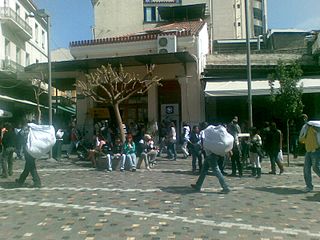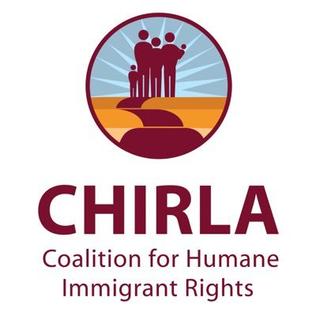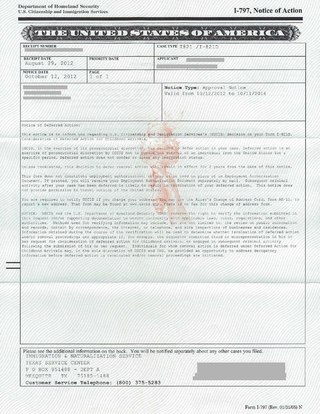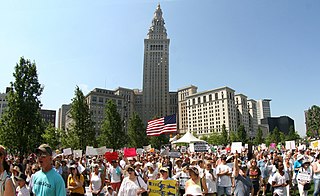U.S. Immigration and Customs Enforcement (ICE) is a federal law enforcement agency under the U.S. Department of Homeland Security. ICE's stated mission is to protect the United States from the cross-border crime and illegal immigration that threaten national security and public safety.

A green card, known officially as a permanent resident card, is an identity document which shows that a person has permanent residency in the United States. Green card holders are formally known as lawful permanent residents (LPRs). As of 2019, there are an estimated 13.9 million green card holders, of whom 9.1 million are eligible to become United States citizens. Approximately 18,700 of them serve in the U.S. Armed Forces.
Anchor baby is a term used to refer to a child born to non-citizen parents in a country that has birthright citizenship which will therefore help the parents and other family members gain legal residency. In the U.S., the term is generally used as a derogatory reference to the supposed role of the child, who automatically qualifies as an American citizen under jus soli and the rights guaranteed in the Fourteenth Amendment to the U.S. Constitution. The term is also often used in the context of the debate over illegal immigration to the United States. A similar term, "passport baby", has been used in Canada for children born through so-called "maternity" or "birth tourism".
Reforming the immigration policy of the United States is a subject of political discourse and contention. Immigration has played an essential part in American history, as except for the Native Americans, everyone in the United States is descended from people who migrated to the United States. Some claim that the United States maintains the world's most liberal immigration policy.

The Development, Relief, and Education for Alien Minors Act, known as the DREAM Act, is a United States legislative proposal to grant temporary conditional residency, with the right to work, to illegal immigrants who entered the United States as minors—and, if they later satisfy further qualifications, they would attain permanent residency.

Canadian immigration and refugee law concerns the area of law related to the admission of foreign nationals into Canada, their rights and responsibilities once admitted, and the conditions of their removal. The primary law on these matters is in the Immigration and Refugee Protection Act, whose goals include economic growth, family reunification, and compliance with humanitarian treaties.

Foreign nationals (aliens) can violate US immigration laws by entering the United States unlawfully or lawfully entering but then remaining after the expiration of their visas, parole, or temporary protected status. Illegal immigration has been a matter of intense debate in the United States since the 1980s.
Illegal immigration is the migration of people into a country in violation of that country's immigration laws, or the continuous residence in a country without the legal right to. Illegal immigration tends to be financially upward, from poorer to richer countries. Illegal residence in another country creates the risk of detention, deportation, and/or other sanctions.

A Form I-766 employment authorization document or EAD card, known popularly as a work permit, is a document issued by the United States Citizenship and Immigration Services (USCIS) that provides temporary employment authorization to noncitizens in the United States.

Immigration to Greece percentage of foreign populations in Greece is 7.1% in proportion to the total population of the country. Moreover, between 9 and 11% of the registered Greek labor force of 4.4 million are foreigners. Migrants additionally make up 25% of wage and salary earners.

The Coalition for Humane Immigrant Rights, also known as CHIRLA, is a Los Angeles county-based organization focusing on immigrant rights. While the organization did evolve from a local level, it is now recognized at a national level. The Coalition for Humane Immigrant Rights of Los Angeles organizes and serves individuals, institutions and coalitions to build power, transform public opinion, and change policies to achieve full human, civil and labor rights. The Coalition for Humane Immigrant Rights of Los Angeles also has aided in passing new laws and policies to benefit the immigrant community regardless of documented status.
During the 18th and most of the 19th centuries, the United States had limited regulation of immigration and naturalization at a national level. Under a mostly prevailing "open border" policy, immigration was generally welcomed, although citizenship was limited to “white persons” as of 1790, and naturalization subject to five year residency requirement as of 1802. Passports and visas were not required for entry to America, rules and procedures for arriving immigrants were determined by local ports of entry or state laws, and processes for naturalization were determined by local county courts.
Under the public charge rule, immigrants to United States classified as Likely or Liable to become a Public Charge may be denied visas or permission to enter the country due to their disabilities or lack of economic resources. The term was introduced in the Immigration Act of 1882. The restriction has remained a major cause for denial of visas and lawful permanent residency ever since; in 1992, about half of those denied immigrant and non-immigrant visas for substantive reasons were denied due to the public charge rule. However, the administrative definition of "public charge" has been subject to major changes, notably in 1999 and 2019.
In the United States, members of the same immigrant family often have differing access to resources. Much literature focuses on inequality between families, but inequality often exists within families as well. Though within-family inequality is not unique to immigrant families, the processes of migration and assimilation into American society provide new channels through which such inequality may emerge.

Deferred Action for Childhood Arrivals, colloquially referred to as DACA, is a United States immigration policy that allows some individuals with unlawful presence in the United States after being brought to the country as children to receive a renewable two-year period of deferred action from deportation and become eligible for an employment authorization document in the U.S. To be eligible for the program, recipients cannot have felonies or serious misdemeanors on their records. Unlike the proposed DREAM Act, DACA does not provide a path to citizenship for recipients. The policy, an executive branch memorandum, was announced by President Barack Obama on June 15, 2012. This followed a campaign by immigrants, advocates and supporters which employed a range of tactics. U.S. Citizenship and Immigration Services (USCIS) began accepting applications for the program on August 15, 2012.

Salvadorans are the second largest Hispanic group in the United States and the second largest foreign born group in Los Angeles. The main wave of immigrants came during the Salvadoran Civil War in the 1980s, in order to escape the violence and political and economic instability in the country. Since then, Salvadorans have continued to migrate to Los Angeles as well as other cities around the United States. The community is well established in Los Angeles and stands as an integral part of its cultural and economic life.

Immigration policy, including illegal immigration to the United States, was a signature issue of former U.S. president Donald Trump's presidential campaign, and his proposed reforms and remarks about this issue generated much publicity. Trump has repeatedly said that illegal immigrants are criminals.

Protests against the Trump administration family separation policy are a reaction to the Trump administration policy of separating children from their parents or guardians who crossed the U.S. border either illegally or to request asylum, jailing the adults and locating the minors at separate facilities under the care of the Department of Health and Human Services.
Federal policy oversees and regulates immigration to the United States and citizenship of the United States. The United States Congress has authority over immigration policy in the United States, and it delegates enforcement to the Department of Homeland Security. Historically, the United States went through a period of loose immigration policy in the early-19th century followed by a period of strict immigration policy in the late-19th and early-20th centuries. Policy areas related to the immigration process include visa policy, asylum policy, and naturalization policy. Policy areas related to illegal immigration include deferral policy and removal policy.

Joe Biden's immigration policy is primarily based on reversing many of the immigration policies of the previous Trump administration. During his first day in office, Biden reversed many of Trump's policies on immigration, such as halting the construction of the Mexican border wall, ending Trump's travel ban restricting travel from 14 countries, and an executive order to reaffirm protections for DACA recipients. The Biden administration and Department of Homeland Security, under leadership of Alejandro Mayorkas, dramatically reined in deportation practices of Immigration and Customs Enforcement (ICE), prioritizing national security and violent crime concerns over petty and nonviolent offenses. However, Biden has also faced criticism for extending Title 42, a Trump administration border restriction that arose due to the COVID-19 pandemic, as well as restarting the use of expediting families in Central America, which can cause families to be sent back in weeks, compared to years for an average immigration case. In the fiscal year 2021, the US Border Patrol confirmed more than 1.6 million encounters with migrants along the US-Mexico border, more than quadruple the number in the previous fiscal year and the largest annual total on record. In January 2023, Biden announced a program to strengthen the admission of immigrants from Cuba, Haiti, Nicaragua, and Venezuela, while at the same time his administration will crack down on those who fail to use the plan's legal pathway and strengthen border security. In May 2023, the Biden Administration approved sending 1,500 more troops to the U.S.-Mexico border following Title 42's expiration.










